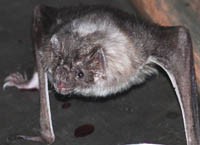Vampire Bats and a Bat Detector

Only a small percentage of bats are blood-drinking vampire bats, like the one shown here, but all bats in the sub-order Microchiroptera use echolocation to help them navigate and locate prey. Image: Wikipedia, Ltshears.
By Kim Mullin
Predators in the Night
What's that whooshing and swooping through the night? What gets its nutrition from bird and mammal blood? What species' animal kingdom name means "hand-wing"? Vampire bats, of course! The idea of blood-thirsty bats may sound like something straight from a movie or Halloween story, but vampire bats are real. While most of the thousand different bat species are harmless, there are three bat species that live on animal blood, all native to Latin America.
Drinking Dinner
You might think that vampire bats have a terrible set of teeth, but they actually have fewer teeth than other types of bats because they drink their meals. Vampire bats make a small cut in an animal's skin and then lap up the blood with their tongue. A special feature of vampire bat saliva keeps the blood liquid so that they can drink for up to half an hour! Otherwise, the cut in the animal's skin would soon coagulate, or start to scab over, just like when you get a small cut on your own body. How can they drink for so long without the prey noticing? They are so light that the animal they drink from continues sleeping through the whole process!
They can drink for a long time, but the amount of blood a vampire bat slurps up isn't enough to hurt its victim. The bigger risk stems from the fact that some vampire bats carry rabies that they can pass on through their bites.
Beyond the Vampires
The blood-drinking habits of vampire bats give "bats" a creepy reputation, but most bats are completely harmless. Bat species live on every continent except Antarctica. Some are voracious insect eaters, vacuuming up hundreds in one night. That's a great benefit to humans and the crops that we eat. Most other bats eat fruit or flower nectar. Just like birds, bees, and butterflies, bats do a great job of pollinating plants and of spreading seeds so new plants can grow.
Bats in the Backyard
Do you have bats in your neighborhood? Maybe you've heard the whoosh of their wings in the night. But with the right tool, you can listen in on the ultrasonic signals they produce to locate objects in their environment. In the Bat Detector: Listen to the Secret Sounds of Bats mammalian biology science project, you can use a bat detector to help you learn more about bat communication. The bat detector is a useful and fun tool for studying the biology of this nocturnal flying mammal.
Categories:
You Might Also Enjoy These Related Posts:
- Plastics and Earth Day - Science Projects
- Arduino Science Projects and Physical Computing
- 10+ Robotics Projects with the BlueBot Kit
- 5 STEM Activities with Marshmallow Peeps
- March Madness Basketball Science Projects: Sports Science Experiments
- Women in STEM! More than 60 Scientists and Engineers for Women's History Month
- Explore Artificial Intelligence and Machine Learning with Student AI Projects
- 10 Reasons to Do the Rubber Band Car Engineering Challenge









